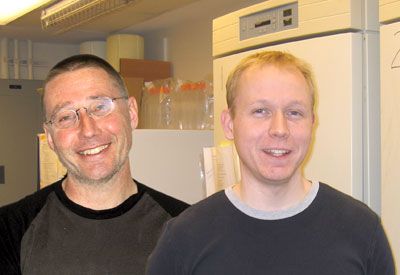(L to R) Andy McMahon and Jan Stenman
All tissues in our bodies require blood vessels for oxygen and nutrients. While all vasculature share certain features, their formation in distinct organ systems occurs by different modes and results in endothelial blood vessels that exhibit properties tailored to the organ’s need. In the brain and spinal cord, which together make up the central nervous system (CNS), the vasculature forms a tight seal generating a physical blood-brain barrier (BBB) quite distinct from the more porous vasculatures permeating other organs. While the BBB favors a stable internal microenvironment suited to brain homeostasis and neural activity, the barrier denies access to potential therapeutic agents that may be beneficial for treatment of CNS diseases.
Several signaling pathways have been identified that generally control vascular development in many different contexts. However, much less is known about mechanisms that govern organ-specific patterns of vascularization and endothelial cell differentiation. In our study, we present evidence that two Wnt-ligands secreted by neural progenitor cells within the developing CNS are critical for development of CNS vasculature.
Wnt7a and Wnt7b are expressed in partially-overlapping patterns within neural progenitors in the developing mouse embryo. While neither single mutant displays an obvious vascular phenotype, vascularization of the CNS fails in compound-mutant embryos. Analysis of Wnt-signaling within the endothelial compartment suggests a direct action of these Wnt signals through a canonical, Wnt-signaling pathway. Further, using both loss-of-function and gain-of-function approaches, we demonstrate that signaling is both necessary and sufficient for the regulation of a critical feature of the early BBB, the up-regulation of a glucose transporter, Glut-1. Thus, these Wnt-signals coordinate formation and early differentiation of the CNS vasculature while vascular development in other tissues appears to be independent of a similar Wnt input. Given the continued expression of these Wnt factors in the adult CNS, it is tempting to speculate that Wnts may also act at later stages in the further development or maintenance of BBB properties. If so, modulating their actions may have important therapeutic implications.




